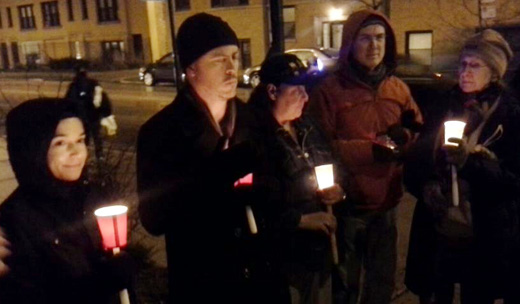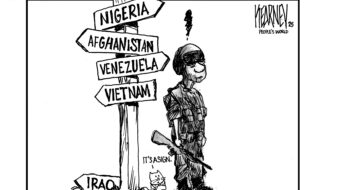
In the days surrounding the Dec. 14 one-year anniversary of the shooting massacre at Sandy Hook Elementary School in Newtown, Conn., news media have reported these gun incidents:
On Dec. 18, a man was shot at a Chicago CTA station. The evening before, also in Chicago, a 16-year-old boy was shot on a neighborhood street.
On Dec. 17, a man started shooting in a Reno, Nev., medical center, killing one person and critically wounding two others before apparently taking his own life, state officials said.
On Dec. 15, two carjackers shot and killed a 30-year-old man in a shopping mall garage in Short Hills, N.J.
On Dec. 13, an 18-year-old high school student opened fire at Arapahoe High School in the Denver suburbs, shooting a 17-year-old fellow student in the head before killing himself. He was armed with a pump-action shotgun he had bought at a local sporting goods store a week earlier, 125 rounds of ammunition, and three incendiary devices, plus a machete, local officials said. (In Colorado 18-year-olds are legally allowed to purchase shotguns and long rifles.) The wounded student is still in a coma in the hospital. This was the 19th school shooting in the U.S. since Sandy Hook.
A host of other Dec. 13-15 shootings are reported by Joe Nocera of The New York Times, one of the daily and weekly gun reports he has done over the past year, detailing the vast number of shootings that often don’t make the headlines.
And earlier in the month, Dec. 3, a 22-year-old student was arrested carrying two handguns on the campus of the University of New Haven, in West Haven, Conn. He had an assault rifle and bullets in his car. Police say they found 2,700 rounds of ammunition and newspaper clippings about the Colorado theater shooting at his home.
Who knows what other shootings may have incurred this month that have not gotten media attention.
Slate’s crowd-sourced gun death tracker, as of Dec. 18, 2013, reports 11,607 people have died from guns in the U.S. since the Newtown shootings, based on media reports. Researchers say about 500 American children and teens are dying from gun wounds every year – a 60 percent increase from a decade ago – and an additional 7,500 are hospitalized for gunshot wounds, up 80 percent since 1997.
In April, four months after Sandy Hook, Forbes magazine columnist Abram Brown wrote, “The nation’s appetite for weapons has never been higher. At least in the 14 years of FBI data on gun sales. The FBI’s figures show seven million guns sold in the last three months, compared to 4.9 million sold in the same period a year earlier and two million sold a decade ago.”
Brown then went on to predict: “With toothless gun legislation coming through Congress, the gun industry’s profits will remain at record highs, as will share prices.”
In fact, no federal gun control legislation was passed this year, except for a renewal of a ban on plastic weapons.
Three days after the Sandy Hook tragedy, the Christian Science Monitor found the gun industry to be “thriving,” reporting that “profits for gunmakers and retailers are setting records.” That year, the U.S. gun and ammunition manufacturing industry brought in an estimated $6 billion in revenue, the report said.
Now, a year later, the nation’s number one gun manufacturer, Sturm, Ruger and Co., based in Southport, Conn., about 25 miles from Newtown, “has seen four consecutive quarters of double-digit net income growth” with profit increasing by an average of 72 percent. In the same period, number two gun maker Smith & Wesson had revenue up by an average of 37 percent, says Forbes.
There were an estimated 310 million guns in circulation in the United States according to the most recent figures (2009). That’s a bit more than one gun for every man, woman, child and newborn baby in the U.S. It includes 114 million handguns, 110 million rifles, and 86 million shotguns. The number of available guns has increased 62 percent since 1994.
Over the past eight years, the firearms industry has donated up to $60.2 million to the gun-lobbying National Rifle Association, according to an updated Violence Policy Center report issued this September, titled “Blood Money II: How Gun Industry Dollars Fund the NRA.” In the past two years, the levels of gun industry donations to the NRA have “risen dramatically,” the center says.
Just after the Sandy Hook killings, the Wall Street Journal reported corporations were looking “to distance themselves from guns and gun makers amid a public outcry.” But, as peoplesworld.org noted then, “unless there is a sustained public movement to curb guns as a source of profit, the corporate profit drive will continue to push guns to make money.”
Photo: Chicagoans hold a vigil to mourn the deaths in Newtown, Conn., last year. John Bachtell/PW










